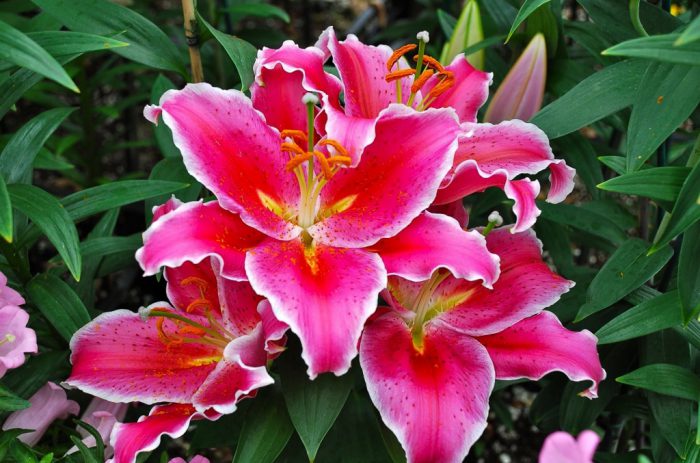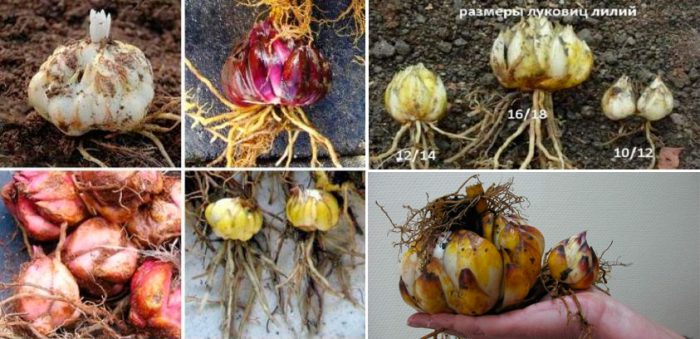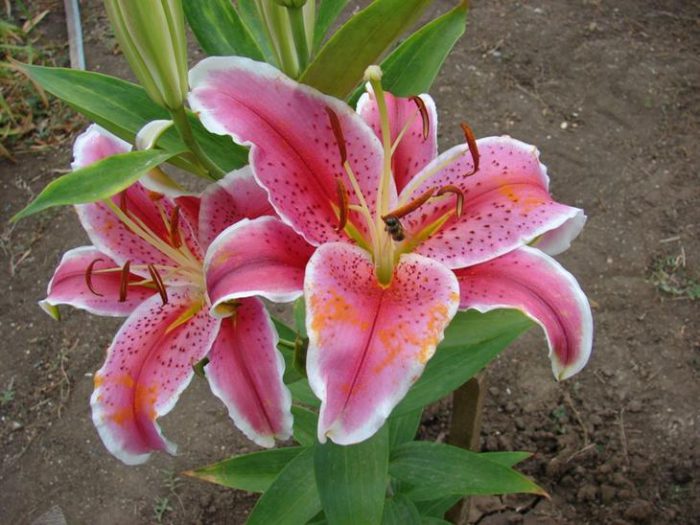A plant such as garden lily is directly related to the lily family. This plant is a bulbous perennial. There are more than 80 different types of lilies in nature. Most of them were very popular among flower growers until, thanks to the efforts of breeders, many hybrid species were born.
Content
Homeland of lily
In natural conditions, lilies can be found in Europe, Asia, and also in North America. A large number of different legends are associated with this beautiful flower. So, in ancient Greece, it was believed that lilies painted white are drops of milk of the goddess Hera. For Christians, this white flower symbolizes the Mother of God.
Lily is often used in heraldry. Also, this plant was not deprived of attention by poets and writers. It has extraordinary beauty, as well as medicinal properties.
Features of lily bulbs
A perennial like a lily grows from a bulb. The bulbs can be very small. So, their diameter can be equal to only 1 cm. But in natural conditions, there are very large bulbs, the diameter of which can reach about 30 cm. Bulbs can have various shapes: ovoid or spherical. A large number of leaf plates are located on the shoots of the plant. The height of the stems can vary from 50 to 250 cm (depending on the species and variety). In some species, the leaf plates are twisted in a spiral, while in others, they are simply assembled into a leaf rosette.
The plant has one cylindrical inflorescence, which includes all flowers. The inflorescence usually contains up to 16 flowers. It happens that up to 30 flowers grow on one plant, while they do not bloom immediately, but gradually. In this case, flowering begins from the top and gradually goes down. On average, each flower can live for about 8 days. In the central part of the flowers there is a pistil and 6 stamens. There are a large number of forms of the flower itself. In the wild, you can find lilies in both white and blue colors, as well as pink, apricot and orange. Also flowers can be multi-colored. The appearance of fruits on the plant occurs in the month of October. They are boxes with seeds inside.
Types of lilies with photos and names
There are a fairly large number of species, both natural and created by breeders. Below are the most popular types.
Asiatic lily
Such plants include hybrid as well as garden species (for example, lily of David, tiger lily, etc.). And the Dutch lily also belongs to them. Such plants are the owners of a relatively small bulb. They grow and develop normally in almost any conditions. They are not afraid of either drought or excessively low air temperatures. This species blooms very early in June. There are compact dwarf varieties, their stem height is not more than 40 cm, however, there are also varieties whose shoot length reaches 100 cm. The flower has the shape of a bowl. A fairly large number of flowers can grow on one bush.
Martagon (Curly hybrid lilies)
There are about 100 different types of such plants. They have rather long stems. These species are distinguished by their high frost resistance. Any soil is suitable for growing all these species, while the illumination does not really matter. However, this hybrid species has not gained much popularity among flower growers.
Candidium hybrids
It was from such a garden form that a lily of a pure white color was formed. This species does not have a very large number of varieties, but their flowers are incredibly fragrant, large enough and painted in rich colors.
This is not a complete list of lily species that grow both in nature and in gardens. Thanks to the work of breeders, all new varieties appear. At the same time, hybrid plants have external differences, and also differ in the necessary growing conditions.
Growing lilies in the open field
Growing lilies is a very fun process. It should be remembered that such a plant has an extremely negative attitude towards the transplant procedure. In this regard, it is recommended to grow it without transplants for several years. For planting lilies, experts advise choosing a sufficiently well-lit place, protected from strong gusts of wind. The most suitable soil for this type of plant should be loose, well-drained and rich in nutrients. In order for the flowers to grow better and hurt less, about 4 weeks before they are planted, ash must be added to the ground and everything must be dug well. Also, humus and peat are suitable for fertilizing the soil, as well as other mineral fertilizers that can be purchased at a specialized store.
When choosing a lily bulb in a flower shop, it is imperative to find out which species this plant is related to. The fact is that the features of care for different types of lilies are somewhat different. You should stop your choice on the strongest bulbs, on the surface of which there are no signs of damage, as well as rot. It should be borne in mind that the minimum root length for bulbs of these flowers is 5 cm.
Landing features
It is necessary to plant lily bulbs in autumn or spring, in some cases this procedure can be carried out in summer. Planting plants in the spring is a fairly popular option. In this case, the bulb will be able to root well, get stronger and not freeze during the winter.
But experts still advise planting lilies in the autumn. The roots have time to start even before the first frost. However, in this case, the grower should take all the necessary measures for the successful wintering of the bulbs. These flowers are usually planted in the first month of autumn. But at this time, the grower may have difficulty buying high-quality bulbs. It is possible during this period to transplant the lilies available on the site.
It should be remembered that it is necessary to plant such plants in spring and autumn according to the same principle. The first step is to prepare the hole by digging it out. At the bottom of the hole, you need to pour sand, and then lower the onion into it.The roots must be carefully straightened, and then again pour sand into the hole. From above, the onion must be covered with soil, and upon completion of planting, you need to water the plant abundantly enough. Planting depth directly depends on the type and variety of lilies. So, it can be equal to 15-30 cm.
A fairly deep planting delays the beginning of flowering, but at the same time such a lily gives a greater number of offspring. By the onset of the autumn period, such a plant has time to grow, and if necessary, at this time, you can transplant a lily by simultaneously multiplying it. However, not in all cases it is required to wait for the onset of the autumn period, so a lily transplant can be carried out immediately after the plant has faded.
Transplant features:
- you need to dig out the flower with a pitchfork (this will protect the bulbs from damage);
- the root system must be doused with water;
- then young shoots are separated and immersed for some time in a weak solution of manganese potassium;
- the roots must be trimmed so that they are about 10 cm long;
- lilies are planted in the soil.
Care features
This flower is not demanding to care for. It needs to be watered on time and weeds removed. During intensive growth, the lily needs a lot of moisture. However, you should try not to flood the plant, as it does not like excessive dampness. On hot summer days, watering is carried out in the morning and evening hours, while it is recommended to mulch the soil so that it does not dry out very quickly.
The 1st feeding is carried out in the spring after the emergence of shoots. When flowering begins, lilies are fed with phosphorus-potassium fertilizer. The fertilizers necessary for feeding can be purchased at a specialized store.
Often, hybrid oriental lilies tolerate wintering very poorly. It is recommended to cover such a flower in rainy weather, this will prevent the soil from getting too wet and the development of rot on the bulbs. It is necessary to air lilies only at a time when the sun is shining.
The lack of flowering may be due to deep planting. The rapid wilting of flowers is associated with overheating of the soil. In this case, its surface must be mulched.


Watch this video on YouTube
Only one pest can appear on the plant - the lily beetle. It is recommended to collect it manually. The fact is that chemical treatment can significantly spoil the appearance of the foliage.
When the lily has faded, you need to wait a while and only then collect the seeds. Watering is carried out until late autumn or before the transplant.
It is necessary to store the bulbs correctly. So, the bulbs should be cleaned from the soil and dried.



















